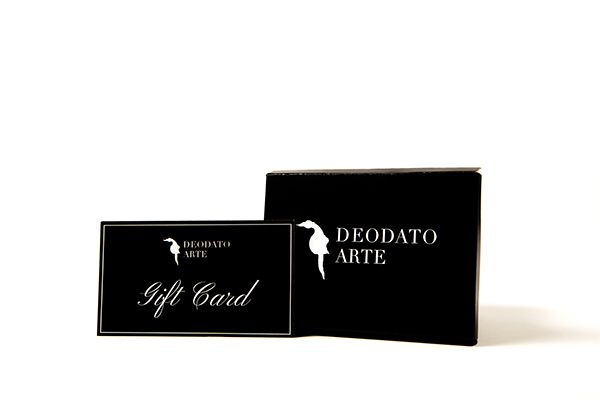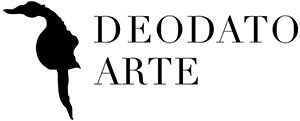
For the occasion of the exhibition "Marco Glaviano: a life of photoshoots", the first of the artist in an Italian gallery, the Deodato Arte gallery presents an exclusive interview that traces, through the words of the photographer, a unique and unrepeatable career.
Born in Sicily, Marco Glaviano has spent much of his life in the United States and he is now one of the most famous contemporary fashion photographers. With his shoots, Glaviano has made immortal the top models who, in the '80s and '90s, embodied the very image of beauty, such as Cindy Crawford, Paulina Porizkova, Claudia Schiffer and Eva Herzigova.
When and how did your passion for photography arise?
I started when I was 6. My uncle was a film screenwriter, when I was 6 he gave me a Leica, which was something incredible for a child back then.
Then things gradually changed, I discovered jazz music and started playing when I was an architecture undergrad, I was pretty keen. However, when I finished my studies at university I quit music and architecture: photography won. My first photos portrayed jazz musicians. Between 1965 and 1966, when I used to play at festivals, I took pics of other musicians, some of them were world-renowned, so much so that some of these photos are still my most important ones. Soon enough, they were in great demand, I was commissioned pictures by the musicians themselves.
I eventually got into the fashion scene, working with illustrious names, who were just kids at the time: Armani, Versace, Ferré, Missoni. The Italian fashion scene that we know today ruled between the late sixties and the early seventies in Italy, in Milan. It wasn’t a change, it was a revolution. What our generation did, let’s say it, was the creation of something that didn’t exist. Now, I would say, there are “incremental” changes; people give their contribution. Frankly, I don’t think that such a radical change in a matter of a few years had ever happened before, and I’m afraid it won’t happen again. Hopefully I’m wrong, but from what I can see, it doesn’t seem likely to me.
Did your move to New York mark the beginning of your career as a photographer?
No, it happened before that. In 1960, I started leaving Palermo from time to time, and little by little I discovered another world. Although Sicily was backwards, compared to the innovations of Northern Italy, intellectually it was leading-edge, because Palermo was a city with a huge potential, with many people of great substance, who I was lucky enough to meet, such as Leonardo Sciascia. I come from a family of artists, as a kid I was lucky enough to be immersed in art, and thus enjoy that kind of cultural support. And then from there to Rome, which however disappointed me.
Hence, one night, after a few months in Rome in a studio, I hired a truck and ran away, I drove to Milan where I arrived at night, in the rain. I was staying in a loft, also for rent. Hence my fashion adventure began in Milan, I started meeting many people who really helped me. Among them, Anna Piaggi, perhaps the most influential journalist in the Italian fashion scene. Anna was married to a great photographer and, with no jealousy on his part, she came to my studio in the evening and helped me try things out. I didn’t even know where to start. Anna, with her generosity, helped me a lot.
Having a foot in the door doesn’t necessarily mean being able to stay. Being introduced is useful, but you need to assert yourself in order to stay. So I started photographing and I stayed in Milan for a few years. Then, in the early ‘70s, I went to New York. I meant to stay for two weeks, I eventually remained there for 45 years, I never came back.
But now you are back...
Yes, but after more than 40 years. I had almost forgotten my Italian. Friends jibed: “Tu vuò fa’ l’Americano” [Song by the Italian musician Renato Carosone, TN]. It was true though, because after a while one starts missing that kind of conviviality, being Italian.
Now I am Sicilian again, luckily the cycle has ended, I am no longer American, even if I am by nationality. Of course I’ve come to appreciate Italy much more now, back then I felt it was somewhat constricting, I wanted to escape, to try other things. And I must say that it paid off, because New York in the ‘70s was a volcano. I used to pay visits to Andy Warhol, things that didn’t exist in Italy. I struggled to stay there, it wasn’t easy, it’s notoriously hard. There were moments of despair, but I had burned all bridges with Italy and I couldn’t go back. I stayed there. In short, for better or worse, I made it, it took a long time.
However, photography has been, and still is, one of my greatest passions along with music. All the arts in general, but I consider architecture the most important one. Because architecture comprises everything: the visual, the dance, the music, the opera, the social. There is everything in architecture.
You have developed an interest in various different things, which eventually converged in your main interest, photography.
Being interested in other things is paramount. One dries up if one devotes oneself to just one discipline. In my opinion, you have to have a dialogue with other people, you have to see what happens around you, and possibly embrace it. I’ve mostly spent half my life in a darkroom every night. Being a photographer doesn’t just mean being outside taking pictures.
Then came the digital experiments: I published the first digital photo in 1982, the Macintosh did not exist yet. I was curious to see the developments, what technological progress would lead to, which is still rolling today. However, I have never forgotten to respect tradition. I know many young photographers who don’t know who Richard Avedon is: you can’t build on emptiness. Throughout the history of humanity, people have built on the experience of those who came before. While today, it seems to me, there’s a tendency to throw away everything that is old and start all over from scratch. In my opinion it will be difficult, I hope they will succeed, but I don’t think so. A foundation to start from is always indispensable, in any field, from science to art, even politics can’t be invented from scratch.
And for you, Marco Glaviano, in addition to Avedon, whom you have already mentioned, who were the masters of photography, your sources of inspiration?
My ideal masters are Richard Avedon and Irving Penn, who I unfortunately I met when I was already a grown up. I met Avedon when I was already 60.
Helmut Newton is certainly one of the photographers who most accompanied my growth: we had a good relationship, sometimes a little less good, depending on his mood swings and mine. But now the fact of having an exhibition at Deodato Art gallery, whose collection includes works by Helmut Newton, fills me with pleasure. We are in the same gallery, it is extraordinary, I could never have imagined it when I was a kid.
It takes two things in my opinion: perseverance, and also a bit of luck. Without a bit of luck certain crucial, life-changing encounters may never occur. And then work, one can’t just sit still and do nothing.
A question on the concept of photography: what is, in your opinion, the relationship between photography and reality? Do you think that photography faithfully represent reality?
A few months back I was talking with Oliviero Toscani, and he said something very interesting that I share: “Certain things exist only because they have been photographed”. It is an exaggeration, on the one hand, but it is true. Because you see one thing, it is there because it has been photographed, otherwise it wouldn’t be there. So there’s this relationship between reality and photography. Unfortunately, or fortunately, this is almost over, because the digital technique has made it impossible to tell reality from fiction, when it’s been done well.
Photographers shape an image according to how they see it in their mind’s eye, it doesn’t necessarily have to be there. Refraining from abusing this tool is important. Hence photography, in my opinion, as a witness of reality has had its day. A typical example is the phenomenon of Instagram and the influencers: you no longer know how this person really is. He, she is who they want to be. Photography no longer reflects the reality of the photographer.
We are increasingly flooded with images.
Absolutely. Back then there was research, scouting by the insiders, fashion journalists were terrific, they discovered talents. It’s all about marketing now, everyone selling their postage-stamp-sized products. Nobody cares whether the image is good or not, as long as it exists.
On the other hand, thanks to art galleries, as is the case with Deodato Art, photography is slowly and finally having the recognition it didn’t enjoy before, because it has taken refuge there, in the only places where it can be seen. Not being able to put it on Vogue every month, we stage it in the galleries. Because people like it, they can appreciate it, they buy it and hang it in their bedrooms. This is what I like most. If people buy, then I think they are really interested, not because of the money, but because a person makes a real and practical investment in something that he truly loves. I really appreciate the passion of these collectors. It actually means that they care.
Specifically, this exhibition will be divided into Icons, your classics, and Polaroid pictures, more intimate, personal images.
Polaroid pictures are evidence of an image that has not been photoshopped. Today the first reaction of those who see a photo of a beautiful woman is: “It’s photoshopped!” Polaroid pics don’t lie. They are becoming more and more popular: Many photographers choose Polaroid because it sets them free from this prejudice that everything is perceived as fake. The Polaroid no longer exists technically, but it has taken on this value as a “true” document. And this has some importance.
A question on models, your muses. Do some of them better reflect your style? Are there traits that are better suited to your shots, hence are more satisfying for you?
My relationship with models in those years was incredible. They were the ones who called the shots, I only acted as a witness. They had a style and an idea of how they wanted to be. These are my models.
Cindy Crawford, for example. She has always called the shots. We had some momentous arguments, we still laugh about it, as we are still in touch. She used to say one thing, I said no, and we argued. But she had a point of view of her own. The same goes for all the greatest models I photographed.
Paulina Porizkova for example. Paulina would leave in the middle of a shooting session and tell me “That’s enough”. I just couldn’t finish a reel. “You already have it, I know”, she went. And she was right. You portray something that has a history that fascinates you. This applies to everything, it also applies to landscapes.
So, which kind of beauty do you aim to achieve in your shots?
Absolutely not outward. There are some coincidences in which there is great external physical beauty and something else, and that’s what matters. The beautiful doll, the Barbie doll, blond with blue eyes, is useless. If this doll is intelligent, if she understands the world, she knows how to move, she knows how to dress, she knows where to go, then she becomes something else, an interesting subject. It’s absolutely false that beautiful women are stupid; this is something experience has taught me. External beauty does not necessarily reflect what is hidden inside.
What’s beauty according to you?
Beauty is like music. Music, after all, consists of three chords, from Bach onwards even less. And these three chords have done some wonderful things. It’s assonance, it’s mathematics. Ultimately, it all boils down math.
There are equations that fit together well and therefore appeal to the human being who needs harmony, in a natural, evolutionary way. When these things converge, a beautiful image is created, a beautiful person. But for this to happen, these elements need to converge, being beautiful is not enough.
Is there today an aesthetics that is particularly promising, offering something original?
Sometimes I come across very interesting models, but a bit out of context. Since there are no longer magazines, but platforms, social networks, it would take a huge amount of time to understand them. There are billions of contents, how does one get to see them all? Let’s face it, in the 1970s and 1980s you bought Vogue America and those who were on the cover were the most beautiful. How would you go about it today? By filtering some billion images on Instagram? Also in magazines, images are anonymous, purposeless, I struggle to see a vision there.
On the other hand, when I used to play jazz my father locked my piano, he didn’t understand me. “He’s mad”, I used to think. Probably the same thing is happening with me nowadays, maybe I am the one who doesn’t understand. And since all young people are like this, and the world goes forwards and not backwards, they are probably right.
What’s art for you?
In my opinion it is harmony in many things, art is something that pleases the senses, all the senses, art can also be a good perfume.
Art is many things, for me it is something that enriches your soul, the way you experience life, it makes you feel good even when things are not going so well. In my opinion this is what art is, to find a simple definition of art that everyone can share. Because I reckon there are some things that can make you feel bad, and are passed off as art. However, as I told you, I’m no expert.











 Register
Register Wishlist
Wishlist Contact Us
Contact Us

